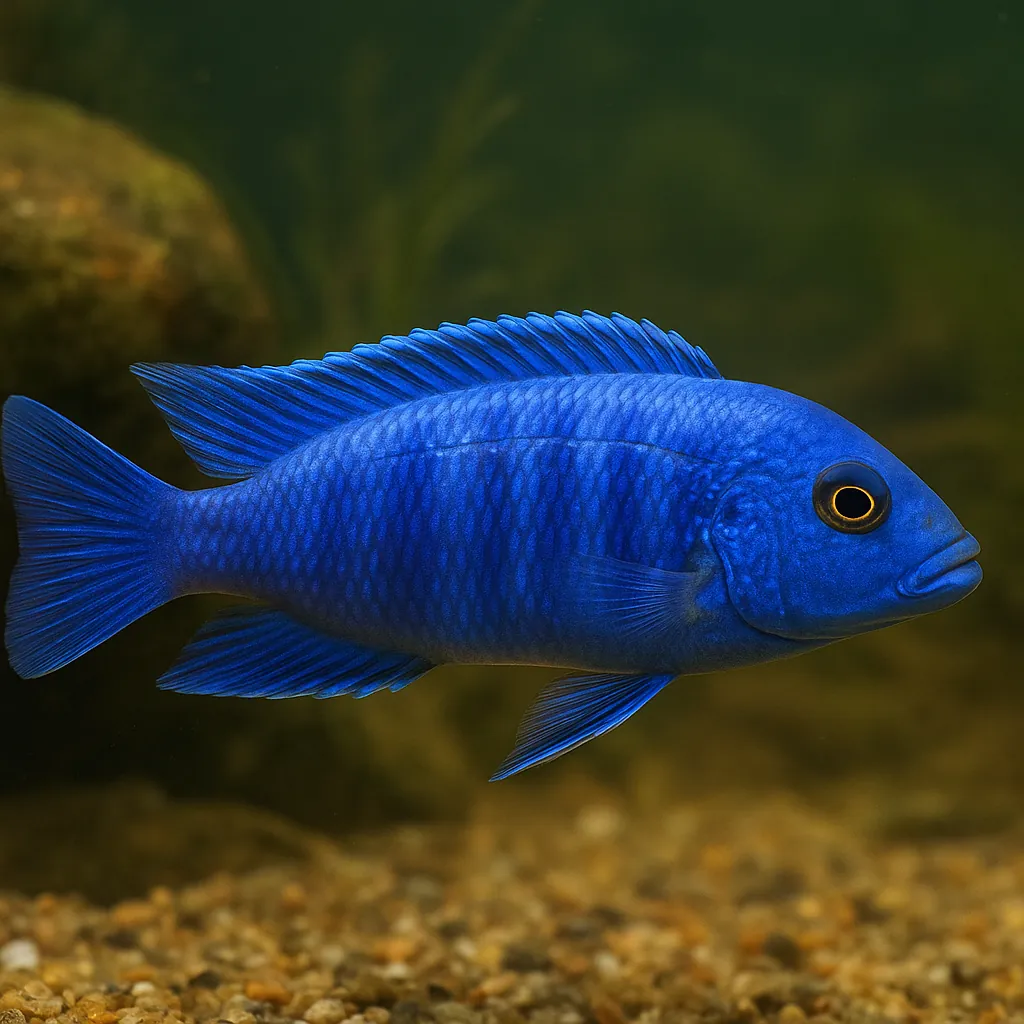
Blue cobalt cichlid
Introduction
The Blue Cobalt Cichlid, scientifically known as Maylandia callainos, is a striking freshwater fish renowned for its vibrant blue coloration and dynamic personality. Native to the rocky shores of Lake Malawi in East Africa, this species has become a favorite among aquarists seeking to add a splash of color and activity to their tanks. While their captivating appearance is a major draw, potential keepers should be aware of their territorial nature and specific care requirements to ensure a healthy and harmonious aquarium environment.
What makes the Blue Cobalt Cichlid appealing to aquarists?
Its brilliant blue hue and active behavior make it a standout addition to any aquarium, providing both visual appeal and engaging dynamics.
Is the Blue Cobalt Cichlid suitable for beginners?
Due to their territorial tendencies and specific care needs, they are better suited for aquarists with some experience in fishkeeping.
Care and Environment
Proper care for the Blue Cobalt Cichlid involves replicating its natural habitat and addressing its behavioral traits. A minimum tank size of 113 liters (30 gallons) is recommended for a single fish, with an additional 75 liters (20 gallons) for each additional cichlid to accommodate their territorial nature. For optimal conditions, especially when housing a group, a tank of at least 200 liters (50 gallons) is ideal.
Water parameters should closely mimic those of Lake Malawi. Maintain a temperature between 24°C and 28°C (75°F to 82°F), a pH level of 7.5 to 8.5, and water hardness between 10 to 20 dGH. Efficient filtration is crucial to handle the bioload and keep the water clean, while moderate water movement helps simulate their natural environment.
When it comes to tank decor, a sandy or fine gravel substrate is preferred, as these cichlids enjoy digging. Incorporate plenty of rocks and caves to provide hiding spots and establish territories, which can help reduce aggression. Hardy plants like Anubias or Java Fern can be added, but ensure they are securely attached to prevent uprooting.
Feeding should consist of a balanced diet rich in vegetable matter. High-quality cichlid pellets or flakes formulated for herbivorous cichlids are suitable, supplemented with blanched vegetables like spinach, zucchini, and peas. Avoid feeding live worms or brine shrimp, as these can cause bloating and health issues.
How can I minimize aggression among Blue Cobalt Cichlids?
Providing ample space, establishing clear territories with rocks and caves, and maintaining appropriate male-to-female ratios can help reduce aggression.
What are the signs of stress or illness in Blue Cobalt Cichlids?
Look for changes in color, loss of appetite, listless swimming, or unusual hiding behavior, which may indicate stress or health issues.
Origin and Habitat
The Blue Cobalt Cichlid is endemic to Lake Malawi in East Africa, specifically inhabiting the rocky regions of the lake. These areas are characterized by abundant crevices and caves, providing shelter and breeding sites. The lake's clear, alkaline waters are rich in minerals, supporting a diverse ecosystem. In the wild, these cichlids are accustomed to moderate water flow and a habitat filled with rocks and minimal vegetation.
Why is it important to replicate their natural habitat in captivity?
Mimicking their natural environment helps reduce stress, encourages natural behaviors, and promotes overall health and well-being.
Do Blue Cobalt Cichlids prefer specific areas within the tank?
They often claim territories among rocks and caves, so providing these structures allows them to exhibit natural behaviors and establish their own spaces.
Temperament and Compatibility
Blue Cobalt Cichlids are known for their territorial and semi-aggressive behavior, especially during breeding periods. They are best kept with other robust African cichlids of similar size and temperament. Suitable tank mates include other Mbuna cichlids like the Yellow Lab (Labidochromis caeruleus) and the Bumblebee Cichlid (Pseudotropheus crabro). Avoid housing them with smaller, more timid fish or species with long, flowing fins, as they may be harassed or attacked.
To manage aggression, it's advisable to maintain a ratio of one male to multiple females and provide ample hiding spots to allow subordinate fish to escape dominant individuals. Overcrowding can sometimes diffuse aggression but requires careful monitoring to ensure water quality and fish health.
Can Blue Cobalt Cichlids be kept with non-cichlid species?
It's generally not recommended, as their aggressive nature can lead to conflicts with more peaceful fish.
How can I tell if my Blue Cobalt Cichlid is stressed due to tank mates?
Signs include hiding more than usual, reduced feeding, faded coloration, or visible injuries from skirmishes.
Interesting Facts
Blue Cobalt Cichlids are mouthbrooders, meaning females carry fertilized eggs in their mouths until they hatch, providing protection during the vulnerable early stages of life. This fascinating behavior showcases their dedication to offspring survival. Additionally, males often display more vibrant coloration and may have pronounced egg spots on their anal fins, which play a role in the breeding process.
In the wild, their diet primarily consists of algae scraped from rocks, highlighting the importance of providing a vegetable-rich diet in captivity. Their natural inclination to dig and rearrange their environment means aquarists should secure tank decorations and choose hardy plants to withstand their activities.
Why do male Blue Cobalt Cichlids have egg spots on their fins?
These spots mimic eggs and play a role in the breeding process, enticing females to attempt to collect them, which facilitates fertilization.
How long do females carry the eggs in their mouths?
Females typically mouthbrood the eggs for about three weeks before releasing the free-swimming fry.
Sources
All information in this article has been gathered from the following reputable sources:
Overview
Recommended Tank Size 52.8 Gallons (for groups of 3 or more) |
Minimum Group Size 1 |
Minimum Tank Volume 29.9 Gallons |
Maximum Adult Length 5.9 inches |
Average Adult Length 4.7 inches |
Shoaling (6+ required) No |
Preferred Water Type Freshwater, hard, alkaline |
Temperature Range (°C) 24–28 |
pH Range 7.5–8.5 |
Water Hardness (dGH) 10–20 |
Typical Lifespan (years) 5 years |